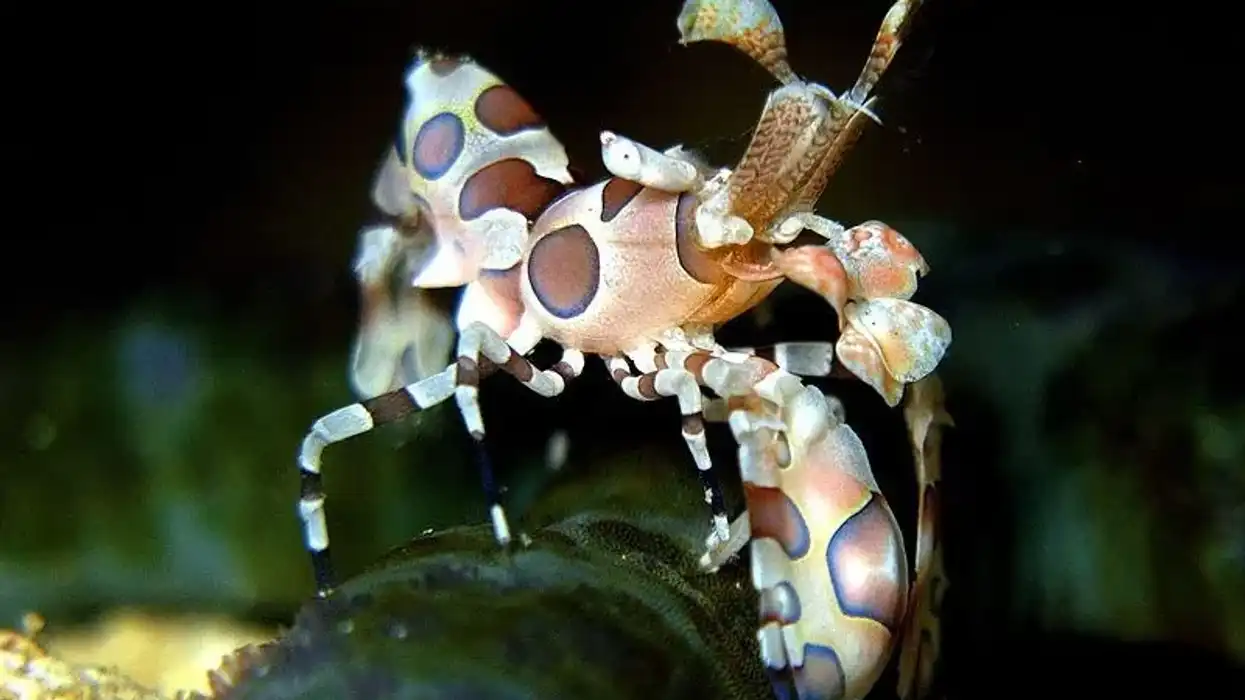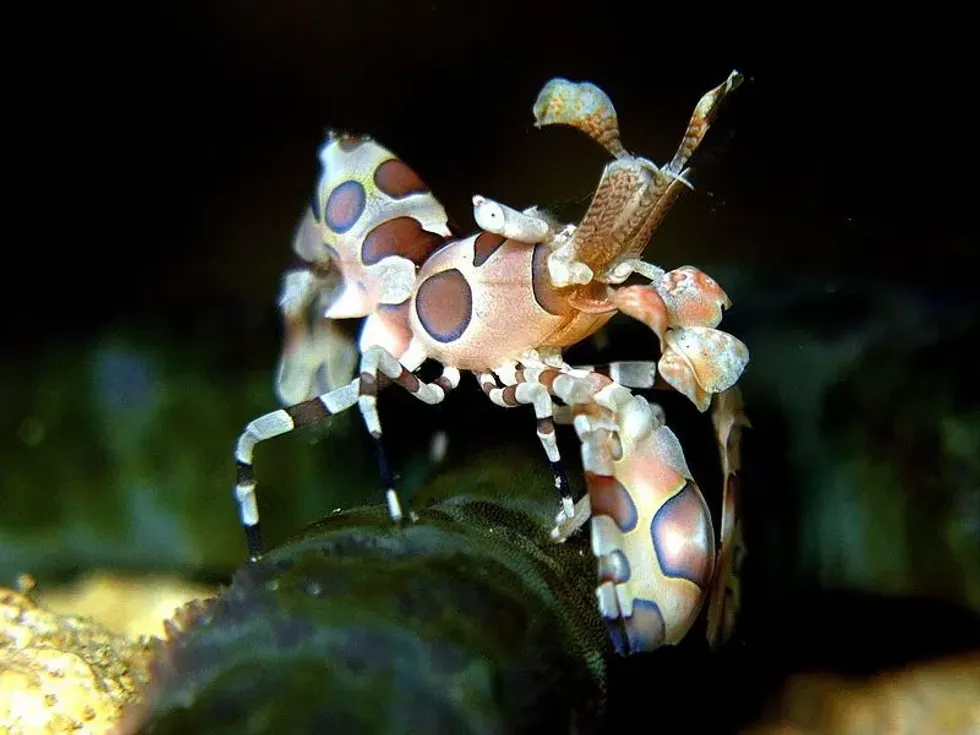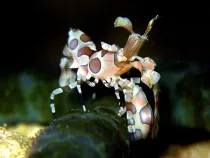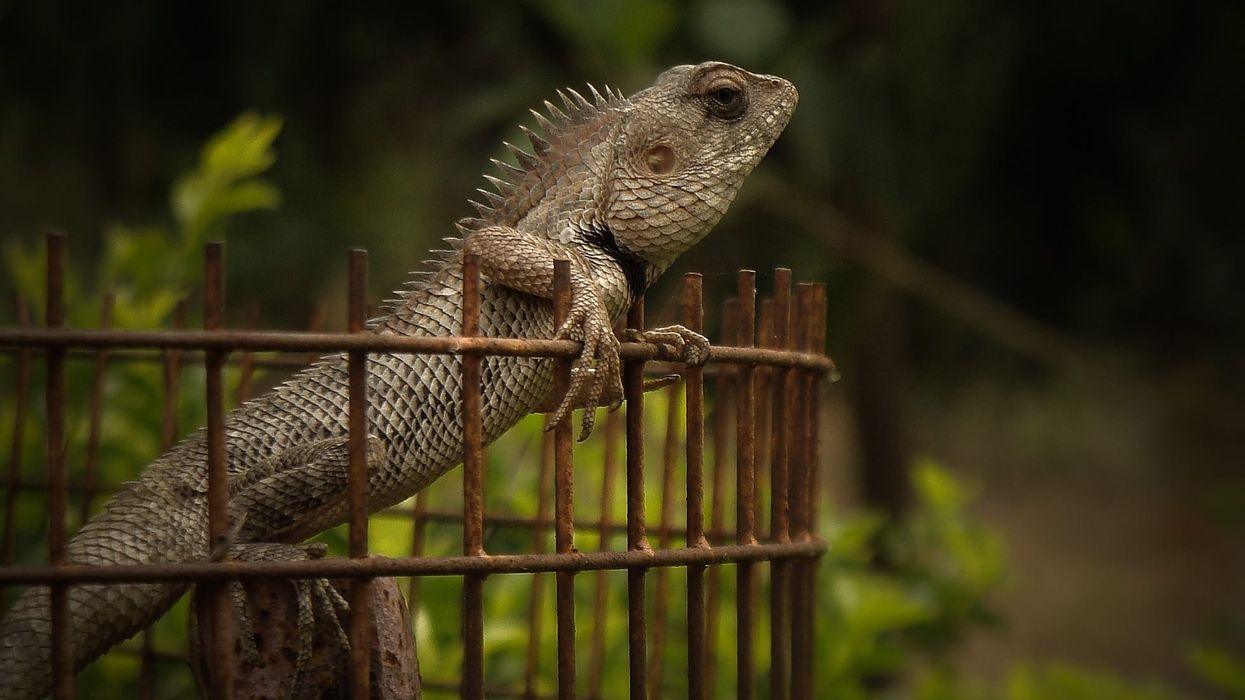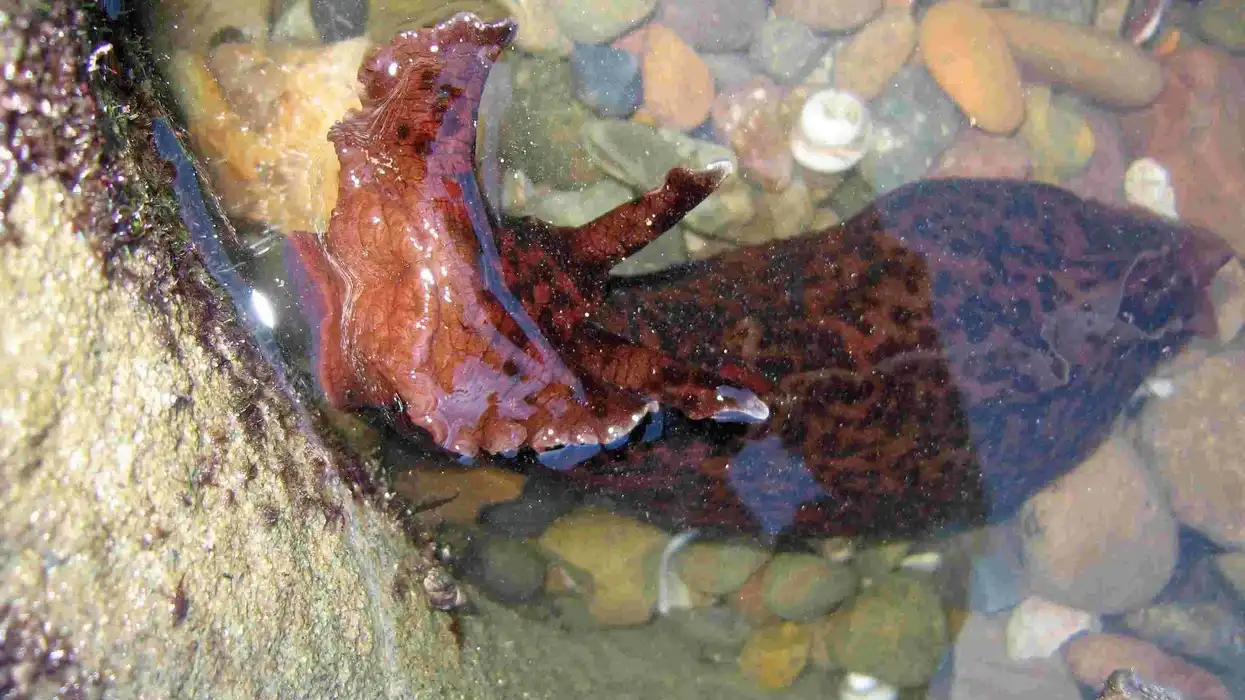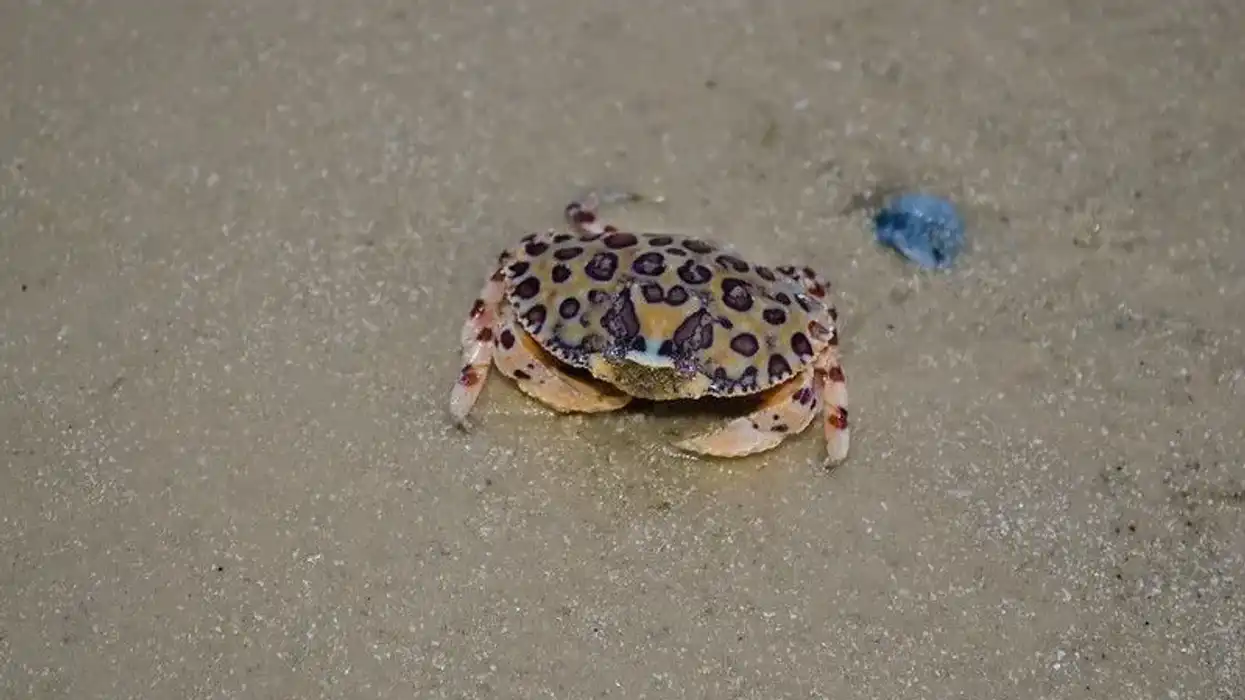Fun Harlequin Shrimp Facts For Kids

The Harlequin Shrimp (Hymenocera picta) is a saltwater fish found mostly in the coral reefs of Hawaii and the tropical Indian Ocean and the Pacific Ocean. Their shell is cream in color with spots of purple and red on it.
They are small-sized shrimps that mostly feed on asterina starfish and blue linckia sea starfish and sometimes on sea urchins. They are predators who are carnivorous in nature and are opportunistic omnivores. They belong to the family Hymenoceridae in the genus Hymenocera.
If you have a question in your mind like 'is Harlequin Shrimp reef safe?' then the answer is yes.
The Harlequin Shrimp is reef safe but as it feasts on asterina starfish, though it should not be kept with the echinoderms. After you have enjoyed these Harlequin Shrimp facts, do check our other articles on the peacock mantis shrimp and ghost shrimp as well.
Harlequin Shrimp Interesting Facts
What type of animal is a Harlequin Shrimp?
The Harlequin Shrimp (Hymenocera elegans) is a fish species found mostly in the coral reefs of the Indo-Pacific region. The body length of the Harlequin Shrimp is less than 2 in (5.1 cm) and they eat starfish and sea urchins. They are also found on the north coast of Australia and Hawaii.
What class of animal does a Harlequin Shrimp belong to?
The Harlequin Shrimp is a fish species that is often found in saltwater. It is found in coral reefs where it eats echinoderms or starfish. They do not eat other crustaceans and coral fish. Their body length is less than 2 in (5.1 cm) and they are carnivorous in nature.
How many Harlequin Shrimps are there in the world?
The exact number of Harlequin Shrimps is not determined and is currently unknown. Their population is reported to be severely decreasing due to the degradation of coral reefs and the unavailability of starfishes. Water pollution is also causing a serious blow to their habitat, which makes survival difficult. The IUCN has not yet evaluated its conservation status.
Where does a Harlequin Shrimp live?
The Harlequin Shrimp lives in the Indo-Pacific Ocean. They are fierce predators who feed on starfish, and if the unavailability of starfish arises, they eat sea urchins as their substitute. They are not very agile and live in saltwater. They are also found in Australia and Hawaii.
What is a Harlequin Shrimp's habitat?
The Harlequin Shrimp is a saltwater crustacean. It has a very exotic appearance and is considered to be one of the most beautiful sea creatures. They can survive in temperatures ranging from 72-82 degrees Fahrenheit (22.2-27.8 degrees Celsius). The coral reefs are their natural habitat where they prey on different species of starfish.
Who do Harlequin Shrimps live with?
Harlequin Shrimps live in pairs, and if they remain undisturbed, they may live their entire lifespan of seven years with their partners. The bond between a male and a female Harlequin Shrimp is strong, and they try to help each other.
Harlequin Shrimps are aggressive in nature and hence do not live in groups. They mate and bond for life with their partners.
How long does a Harlequin Shrimp live?
The average lifespan of a Harlequin Shrimp is seven years. The salinity of the water, optimal temperature, availability of prey, and various other factors affect the life expectancy of the Hymenocera picta.
If kept in an aquarium, they must be fed with starfish and the salinity level of the water should be checked, and the water temperature should not exceed 82 degrees Fahrenheit (27.8 degrees Celsius).
How do they reproduce?
The female Harlequin Shrimp attains sexual maturity after a span of 200-240 days. Once a breeding pair is established, the male and the female spend a lot of time together and share the same cave—the females, after reaching maturity, spawn after every molting phase.
The eggs are fertilized after passing through the spermatophores. After the fertilization process is complete, the female holds these eggs in her abdomen.
The female will carry these eggs for two to five weeks. After 10-12 days of gestation, small larvae will emerge from the eggs, which need a settlement period of another five weeks.
What is their conservation status?
The conservation status of Harlequin Shrimp or the Hymenocera picta is currently not known. This fish species is not evaluated by the IUCN and hence their status cannot be confirmed. Though according to many reports, it is seen that the population of these species is declining due to the degradation of coral reefs.
Harlequin Shrimp Fun Facts
What do Harlequin Shrimps look like?
Harlequin Shrimps are crustaceans that live in saltwater and have a shell that is cream colored along with purple and red spots. Occasionally, a few Harlequin Shrimp also have white spots over them. They look very attractive underwater and are kept as pets in aquariums.
They have two legs on each side for walking and large claws. The eyes and the claws appear to be flat in shape. These large claws are also known as chelipeds.
There are two species of Harlequin Shrimps, commonly known as the Hymenocera picta having purple and red spots on a cream-colored shell and found in the coral reefs of the Indo-pacific Ocean. The Hymenocera picta are also called Hawaiian Harlequin Shrimp as they are spotted by scuba divers in Hawaii.
The second species of the Harlequin Shrimp is known as the Hymenocera elegans, which are spotted in Myanmar. The Harlequin Shrimp is often called the painted shrimp due to its vibrant color scheme
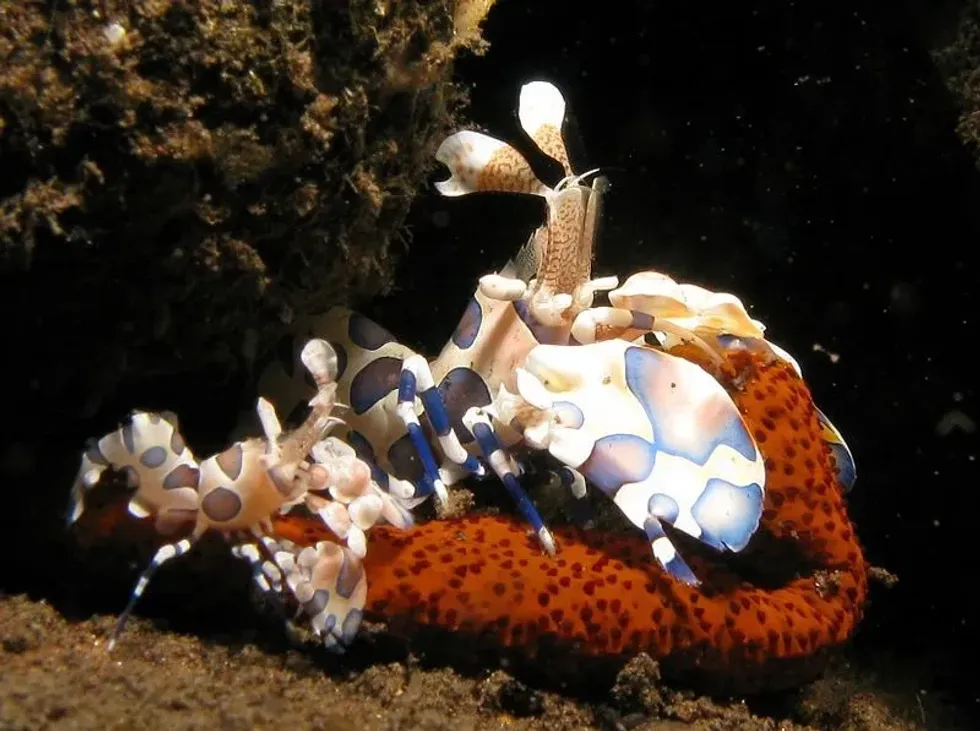
How cute are they?
They are not but look very appealing due to their color scheme. They have large claws usually used for preying on starfish. They are kept as house pets in an aquarium because of their colorful appearance. They are mostly found in coral reefs, which is suggested to be their natural habitat.
How do they communicate?
Harlequin Shrimps usually are aggressive towards other shrimps as well as shrimps belonging to their own family. They are peaceful with coral fishes and other crustaceans.
They disappear into their caves when approached by a predator. They mostly live in pairs after a mating pair is established and spend their entire time with their mates. Precopulatory courtship is common in Harlequin Shrimp as they allow their mate in their caves.
How big is a Harlequin Shrimp?
The average body length of a Harlequin Shrimp is less than 2 in (5.1 cm). They are not very big and feed on starfishes and sometimes sea urchins. They escape into their caves when threatened or disturbed. Their average weight is only a few ounces.
How fast can Harlequin Shrimps move?
They are not very agile but are quick in preying on starfishes. This marine fish moves slowly in the water and can be threatened by any fast-moving fish which will make them rush into their cave.
They are attracted to any object which looks like a starfish.
The male and the female Harlequin Shrimp catch the starfish with their powerful, large pincers and move their prey to its den. While doing so, the tube-like feet of the starfish are exposed to the Harlequin Shrimps on which they feast while the starfish is alive.
How much does a Harlequin Shrimp weigh?
The weight of a Harlequin Shrimp is only a few ounces. The average body length of a Harlequin Shrimp is 1-2 in (2.5-5.1 cm). They are crustaceans and prefer saline water over fresh water to live. Their natural habitat is a coral reef where they feed on echinoderms.
What are the male and female names of the species?
The male and the female species of Hymenocera picta are commonly called male Harlequin Shrimp and female Harlequin shrimp. They do not have distinctive names. After forming a successful pair, they feed, prey, eat and spend time together in a cave. In terms of size, females are larger than males.
What would you call a baby Harlequin Shrimp?
A baby Harlequin Shrimp does not have a specific scientific name. The juveniles of a Harlequin Shrimp are vulnerable and can be hunted down by multiple sea creatures, both big and small.
What do they eat?
The Harlequin Shrimp eat starfish primarily and sometimes they eat sea urchins as part of their diet as well. They eat starfish (asterina) as it deals effectively with the problem of parasite infestation. Their diet is primarily comprising of echinoderms (asterina).
Are they harmful?
No, the Harlequin Shrimps do not pose any threat to human beings. In fact, human beings are a great threat to their population. The degradation of coral reefs due to human activities, pollution of water, and fishing for these species is causing their population to decline day by day.
Would they make a good pet?
Harlequin Shrimps are considered to be one of the most good-looking and appealing sea creatures. They are kept in aquariums or reef tanks as pets by many human beings who are flattered by their appearance.
Aquarium enthusiasts also try to catch these shrimps in order to gain money by selling them and putting them on display. They can feed on starfish for a long time and are very low maintenance.
Even though they can survive as pets in pairs, they should be left in their natural habitat. Before you get this animal as a pet for your aquarium or reef tank, do get some knowledge about Harlequin Shrimp care and Harlequin Shrimp food as their diet is quite expensive.
Did you know...
Harlequin Shrimps are known to hunt down fishes that are 100 times their own size. The female Harlequin Shrimp are larger than the males. They are known for their creepy feeding process and enjoy eating a starfish arm by arm until it grows all its arms back.
You should not move a Harlequin Shrimp into an aquarium that has a strong current. While some species need this to survive, Harlequin Shrimps do not, so this means such fishes are not the best tank mates for this shrimp species.
Hence, you must only move a shrimp into an aquarium with a mild current and tank mates with whom it is compatible.
The Harlequin Shrimp's feeding process
The Harlequin Shrimp are known to feed on starfish by hunting it down with the help of their mating partner. The pair catches the starfish by their large pincers and drags the starfish to their cave.
While doing so, the tube-shaped feet of the starfish are exposed to the shrimps and they feast on it while the starfish is breathing. The starfish dies a slow and painful death.
The body parts which are eaten off by the shrimp pair grow back and the process of feeding continues.
It is also reported that some Harlequin Shrimps feed the starfish in order to feed on it. Two to four starfishes are devoured by an adult pair of Harlequin Shrimps in a span of one week.
Keeping Harlequin Shrimp
Harlequin Shrimps should be kept in an aquarium of 10 gallons which must include numerous caves. The salinity of the water along with its temperature must be checked, or else the crustacean may not survive in it.
As the Harlequin Shrimp only eats a starfish, they can be expensive to keep. Other species of cheap starfishes can also be fed to a Harlequin Shrimp.
It is important to note that Harlequin Shrimps must be bought in a pair only then they could live their entire lifespan of seven years.
They must also be left undisturbed, and a low light must be provided to them. Even though they are beautiful to look at, they must be left in the wild and be allowed to survive in their natural habitat.
Here at Kidadl, we have carefully created lots of interesting family-friendly animal facts for everyone to discover! Learn more about some other arthropods from our slipper lobster facts, and irukandji jellyfish fun facts pages.
You can even occupy yourself at home by coloring in one of our free printable Harlequin Shrimp coloring pages.
We Want Your Photos!
More for You
Bachelor of Science specializing in Mass Communication.

Adekunle Olanrewaju JasonBachelor of Science specializing in Mass Communication.
Bachelor of Journalism and Mass Communication

Ankit ShindeBachelor of Journalism and Mass Communication
Ankit is a Journalism and Mass Media graduate from the University of Mumbai. With experience in SEO, blog and article writing, and fiction writing, he is a versatile writer and content creator. In his free time, Ankit enjoys reading, writing, and listening to music.
Disclaimer
1) Kidadl is independent and to make our service free to you the reader we are supported by advertising. We hope you love our recommendations for products and services! What we suggest is selected independently by the Kidadl team. If you purchase using the Buy Now button we may earn a small commission. This does not influence our choices. Prices are correct and items are available at the time the article was published but we cannot guarantee that on the time of reading. Please note that Kidadl is a participant in the Amazon Services LLC Associates Program, an affiliate advertising program designed to provide a means for sites to earn advertising fees by advertising and linking to Amazon. We also link to other websites, but are not responsible for their content.
2) At Kidadl, we strive to recommend the very best activities and events. We will always aim to give you accurate information at the date of publication - however, information does change, so it’s important you do your own research, double-check and make the decision that is right for your family. We recognise that not all activities and ideas are appropriate for all children and families or in all circumstances. Our recommended activities are based on age but these are a guide. We recommend that these ideas are used as inspiration, that ideas are undertaken with appropriate adult supervision, and that each adult uses their own discretion and knowledge of their children to consider the safety and suitability. Kidadl cannot accept liability for the execution of these ideas, and parental supervision is advised at all times, as safety is paramount. Anyone using the information provided by Kidadl does so at their own risk and we can not accept liability if things go wrong.
3) Because we are an educational resource, we have quotes and facts about a range of historical and modern figures. We do not endorse the actions of or rhetoric of all the people included in these collections, but we think they are important for growing minds to learn about under the guidance of parents or guardians.
